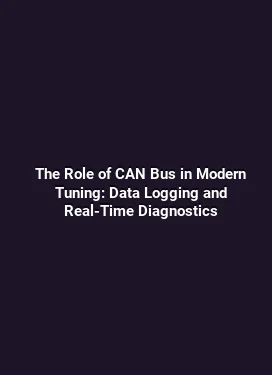Best Knock Detection Methods: Audio vs Sensor Based Systems
In modern engine management and tuning, accurately detecting engine knock is critical for maintaining performance, reliability, and efficiency. This article undertakes a thorough examination of two primary detection paradigms: audio-based systems that listen to the combustion chamber, and sensor-based systems that rely on physical vibrations and pressure cues gathered from dedicated sensors. By exploring technical foundations, real-world performance, integration considerations with engine control units, and practical calibration workflows, readers will gain actionable knowledge to inform setup decisions for a wide range of engine platforms.
Knock Detection: An Overview

Knock, or abnormal combustion, occurs when the flame front accelerates uncontrollably, creating pressure oscillations that can harm pistons, rods, and bearings if left unchecked. Detecting these events quickly and accurately enables early timing adjustments, fueling strategies, and cooling interventions that preserve engine health and optimize power delivery. Two broad families of detection approaches dominate the landscape: acoustic analysis, which interprets sound signatures generated within or near the combustion chamber, and sensor-based methods, which monitor mechanical and electrical signals induced by the knock event.
Understanding the tradeoffs between these approaches is essential for engine builders and tuners. Acoustic detection can be highly sensitive to the exact combustion chamber geometry and instrumentation, but it benefits from relatively non-invasive installation and the potential to capture subtle signals before mechanical stress becomes pronounced. Sensor-based approaches, often leveraging piezoelectric sensors or accelerometers, provide robust, repeatable measurements that are closely tied to the actual pressure and vibration phenomena, yet they require careful placement and signal conditioning to avoid cross-talk and environmental noise. The best solutions in high-performance applications often blend both modalities, leveraging their complementary strengths to improve reliability and accuracy across operating conditions.
Audio-Based Knock Detection: Principles and Practicalities
Fundamental concepts of acoustic sensing

Audio-based detection relies on microphone-like sensing elements placed in proximity to the combustion chamber or in the intake/exhaust tract to capture pressure waves associated with knocking. The raw waveform is processed to extract features such as high-frequency energy bursts, spectral peaks, and temporal patterns that deviate from normal combustion signatures. These features feed a decision algorithm, which can be rule-based, heuristic, or data-driven, to indicate a knock event. A key advantage of this approach is its potential to sense micro-events that precede mechanical distress, enabling proactive timing or fueling adjustments.
Practical implementation requires attention to acoustic coupling, sensor placement, and shielding from extraneous noise. For engines with complex intake manifolds or turbocharging, path-dependent attenuation and room acoustics can influence signal quality. Signal conditioning—such as bandpass filtering, dynamic range optimization, and veto logic when vibration from other sources dominates—helps maintain robust detection across RPM ranges and load conditions.
Signal processing pipeline and feature extraction
In acoustic detection, the processing chain typically includes pre-filtering to isolate the frequency bands where knock energy is most prominent, followed by time-frequency analysis such as short-time Fourier transforms or wavelet methods. Features may include spectral centroid shifts, energy in high-frequency bands, and entropy measures that reflect the randomness of the signal. The pipeline must adapt to engine-specific acoustics, including cylinder count, bore/stroke, and combustion chamber design, to minimize false positives from intake noise, valve train chatter, or exhaust pulses.
Modern implementations often integrate machine learning models that map feature vectors to knock likelihood. These models are trained on diverse operating regimes, including cold start, part-throttle, and high-load high-boost conditions, to generalize across the typical spectrum of engine behavior. A crucial aspect is calibration: models should be exposed to data representing both healthy operation and controlled knock events to distinguish genuine knock from benign acoustic transients.
Sensor-Based Knock Detection: Methods and Deployment
Types of sensors and their sensing principles
Sensor-based systems commonly use piezoelectric knock sensors attached to the engine block or cylinder head, leveraging accelerometer principles to detect the rapid pressure-induced vibrations that characterize knock. Some implementations use surface-mounted accelerometers or integrated crankcase sensors that monitor high-frequency vibration components. The choice of sensor affects sensitivity, frequency response, and noise immunity. Sensor fusion, combining inputs from multiple channels, enhances robustness by countering mounting variations and local resonance effects.
Another category relies on combustion pressure sensors that directly measure in-cylinder pressure oscillations. While these sensors offer rich data about the actual pressure waveform, they require more invasive installation and higher data bandwidth. They provide a more direct readout of knock events, reducing ambiguities that can arise from surface vibrations alone. For many tuning scenarios, a combination of a standard knock sensor and a pressure sensor yields the best of both worlds: quick, broad detection with the option for precise, in-cylinder confirmation when needed.
Signal conditioning and interpretation
Sensor-based knock signals typically exhibit high-frequency content that must be filtered to avoid false triggers from engine noise such as fuel injectors, valve events, and accessory drive vibrations. Conditioning steps include sensor bias stabilization, analog filtering with carefully chosen corner frequencies, and digital thresholding or pattern recognition to identify knock bursts. Reliability improves with age-aware calibration, as sensor sensitivity can drift due to mounting torque, gasket wear, or temperature changes.
Interpreting sensor data relies on timing alignment with the engine cycle. Since knock occurs at specific crank angles under certain pressures and temperatures, synchronization with the engine control unit (ECU) is essential. Real-time pipelines are designed to detect a knock window during each cylinder firing, enabling immediate adjustments to ignition timing or fueling. Sensor redundancy and health checks help ensure that a single faulty channel does not compromise overall detection integrity.
Comparative Performance: When Audio Outperforms Sensor and vice versa
Audio-based systems tend to excel in environments where mechanical couplings are noisy or where sensor mounting is challenging due to space constraints or vibration isolation requirements. They can provide early warning signals by detecting characteristic high-frequency bursts before mechanical stress becomes significant. However, acoustic signals are susceptible to ambient noise, reverberation, and cross-talk from neighboring cylinders or external sources. In engines with aggressive intake and exhaust acoustics, careful calibration and sophisticated filtering are crucial to prevent misinterpretation.
Sensor-based approaches shine in terms of direct measurement of the vibrational energy and pressure perturbations associated with knock. They are generally robust to external acoustic noise and can operate reliably across a wide range of RPM and load. The drawback can be a reliance on precise mounting and potential sensitivity to engine design where structural modes interact with the signal. Sensor-based setups often benefit from redundancy and calibration routines that account for mounting changes over time, as well as temperature-related drift in sensor response.
Hybrid and Integrated Solutions: Leveraging Complementary Strengths
In high-performance engines, combining audio and sensor modalities can reduce false positives and enhance detection confidence. Hybrid systems may use audio as a primary detector for fast response, with sensors providing corroboration and deeper analysis when needed. Data fusion strategies—ranging from simple majority voting to probabilistic fusion and hierarchical decision logic—allow engineers to tune the sensitivity and specificity balance tailored to the engine’s operating envelope.
Integration with the engine management system is a critical design consideration. Both acoustic and sensor signals must be time-aligned with the ignition events to ensure timely countermeasures such as retarding spark timing, adjusting fuel trim, or activating knock suppression strategies. Modern ECU architectures support configurable knock detection algorithms, thresholds, and learning modes that adapt to wear, fuel quality, and elevation-related air density changes, enabling sustained performance over the life of the engine.
Practical Tuning and Calibration Workflows
The tuning workflow typically begins with baseline data collection across representative operating conditions, including cold starts, light cruising, and high-load bursts. Engineers record both raw acoustic signals and sensor readings while noting the corresponding engine state, providing a labeled dataset for subsequent analysis. This data informs threshold selection, filter settings, and the choice of features that best discriminate knock events from benign transients.
Calibration steps emphasize preventing false positives that can cause unnecessary timing adjustments, which degrade performance and drivability. Techniques include dynamic thresholding that adapts to RPM and load, hysteresis to prevent rapid toggling of knock suppression, and region-specific parameters for different cylinders or bank pairs. Routine checks during maintenance should verify sensor integrity, mount torque, and cable routing to preserve signal quality over time.
Data Handling, Feature Relationships, and Practical Insights
Behind every robust detection system lies thoughtful feature engineering that captures the essence of knock signatures without overfitting to a narrow operating window. Relevant features include energy concentration in high-frequency bands, waveform symmetry, cross-cylinder correlation of blow-down events, and temporal patterns that distinguish true knock from transient mechanical noises. Correlation analysis across multiple sensors or microphones helps identify common knock events and reduces the risk of misinterpretation due to local anomalies.
In practice, a tuner's toolbox benefits from a structured validation approach: testing under varied fuels, temperatures, and ambient conditions, and cross-verifying automatic detections with dyno or on-road measurements. This disciplined workflow ensures that the chosen detection strategy remains effective as the engine ages and as fuel quality fluctuates. The aim is to achieve a stable balance between sensitivity and specificity that preserves performance without compromising reliability.
Future Trends and Operators’ Takeaways
Advances in real-time signal processing, adaptive learning, and sensor materials are expanding the capabilities of knock detection. The trend toward more granular, cylinder-specific monitoring opens avenues for precision tuning, such as differential timing strategies and adaptive fueling that respond to localized knock propensity. In practice, staying informed about sensor health diagnostics, calibration routines, and data-driven tuning methodologies will help maintain robust knock management across an engine’s lifecycle.
Operators should also consider environmental and regulatory factors, such as fuel formulation variability, turbocharger behavior, and emission-related constraints that influence knock propensity. A flexible detection framework that accommodates both acoustic and sensor inputs, with clear health indicators and maintenance guidelines, provides a resilient foundation for high-performance and endurance applications alike.






